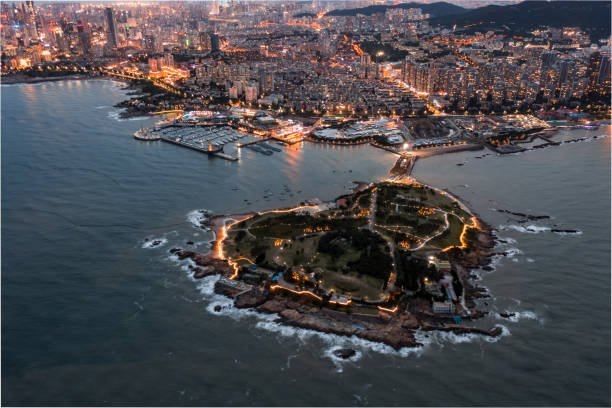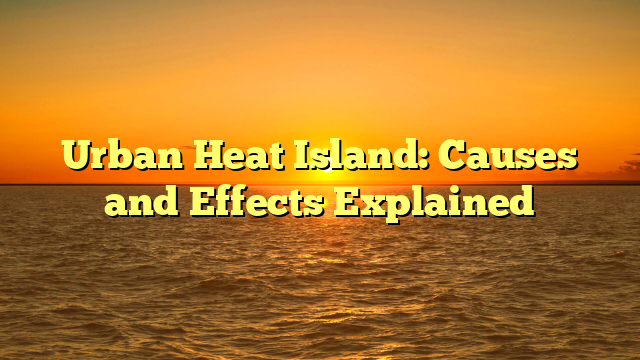Urban Heat Island
In an period marked by speedy urbanization, local weather change, and rising environmental considerations, the phenomenon generally known as the city warmth island (UHI) has emerged as a big focus of analysis and dialogue. Merely put, the city warmth island refers to city areas that have increased temperatures than their rural counterparts. This temperature disparity not solely impacts the encompassing surroundings but additionally poses severe challenges to public well being, vitality consumption, and biodiversity. On this article, we’ll discover the causes and results of city warmth islands, serving to you perceive why this phenomenon issues and what may be accomplished about it.
What’s an City Warmth Island?

An city warmth island (UHI) is a localized space inside a metropolis that experiences considerably increased temperatures than the encompassing rural areas. This phenomenon outcomes from a mix of things, together with human actions, constructing supplies, and vegetation cowl. In cities, the focus of buildings, roads, and different heat-absorbing supplies causes daytime warmth to be trapped and launched slowly at evening, leading to hotter nighttime temperatures.
Key Statistics
For example the affect of city warmth islands, contemplate these findings:
-
- Temperature Improve: City areas may be 2 to five levels Fahrenheit hotter than surrounding rural areas.
-
- Vitality Consumption: Cooling vitality use in cities can enhance by as much as 30% on account of increased temperatures.
-
- Public Well being Dangers: Publicity to excessive warmth can exacerbate well being points akin to warmth exhaustion and respiratory illnesses, particularly in susceptible populations.
Causes of City Warmth Islands
Understanding the causes of city warmth islands is essential for growing efficient mitigation methods. Listed below are the first components contributing to this phenomenon:
1. City Improvement and Infrastructure
The supplies utilized in city development—like asphalt, concrete, and brick—are glorious at absorbing warmth. When the solar shines on these surfaces, they keep warmth, resulting in elevated temperatures in city areas. Moreover, the restricted vegetation in cities inhibits the pure cooling processes that happen in rural areas.
2. Lack of Vegetation
Crops play a crucial function in cooling the surroundings by way of a course of generally known as evapotranspiration. In cities, inexperienced areas, parks, and bushes are sometimes restricted, lowering this pure cooling impact. As cities proceed to develop, the displacement of vegetation not solely exacerbates the city warmth island impact but additionally diminishes air high quality.
3. Vehicular Emissions
Automobile emissions contribute to warmth technology as nicely. The warmth launched by automobiles, together with pollution akin to carbon dioxide, can result in elevated atmospheric temperatures. Heavy site visitors areas inside cities typically amplify UHI results on account of each warmth technology and the darkish surfaces that take up warmth.
4. Waste Warmth from Vitality Use
City areas are hubs of vitality consumption, releasing vital quantities of waste warmth generated from buildings, factories, and automobiles. This waste warmth additional contributes to the warming of city environments, significantly throughout the summer time months when vitality use peaks on account of air-con and refrigeration.
Results of City Warmth Islands
The implications of the city warmth island impact are wide-ranging and have an effect on numerous points of city life:
1. Elevated Vitality Demand
One of the vital rapid impacts of city warmth islands is the heightened demand for vitality, significantly for cooling programs like air-con. As temperatures rise, cities expertise increased vitality prices and pressure on electrical grids, resulting in potential blackouts throughout peak summer time months.
2. Deteriorating Air High quality
Larger temperatures can exacerbate air air pollution ranges, which may result in severe well being penalties. For example, elevated ground-level ozone concentrations are related to hotter temperatures and may worsen respiratory situations. In city areas with dense populations, the general public well being implications of deteriorating air high quality may be extreme.
3. Public Well being Dangers
City warmth islands pose direct well being dangers, significantly for susceptible populations such because the aged, kids, and people with pre-existing well being situations. Warmth-related diseases can enhance, together with warmth exhaustion and heatstroke. The results of extended warmth publicity may be deadly, resulting in extra heat-related mortality, significantly in marginalized communities missing entry to cooling sources.
4. Impression on Water Our bodies
City warmth islands can result in elevated water temperatures in close by lakes and rivers. Hotter water holds much less oxygen, threatening aquatic ecosystems and biodiversity. Species that depend on cooler water temperatures can expertise stress, disrupting meals chains and resulting in declines in fish populations.
5. Altered Climate Patterns
The city warmth island impact can even modify native climate patterns. Elevated temperatures can alter precipitation patterns, resulting in heavier and extra intense rainfall occasions in some circumstances, which may enhance the danger of flooding.
Mitigation Methods
Whereas the challenges posed by city warmth islands are vital, quite a few methods may be employed to counteract this impact. Listed below are some actionable insights for communities and metropolis planners:
1. Improve Inexperienced Areas
Enhancing city vegetation by way of parks, inexperienced roofs, and road bushes can considerably assist mitigate UHI results. These inexperienced areas present much-needed shade and enhance the method of evapotranspiration, resulting in cooler temperatures.
2. Implement Cool Roofs
Utilizing reflective supplies for roofing may help scale back warmth absorption in buildings. Cool roofs can considerably decrease rooftop temperatures, successfully lowering the city warmth island impact and decreasing cooling prices.
3. City Forestry Applications
Investing in city forestry applications that promote tree planting can supply long-lasting advantages. Timber not solely present shade but additionally enhance air high quality, improve aesthetic worth, and enhance stormwater administration capabilities.
4. Encourage Sustainable Transportation
Encouraging public transportation, biking, and strolling can scale back warmth generated from vehicular emissions. Cities can develop infrastructure that helps these modes of transportation, lowering dependency on automobiles.
5. City Planning Insurance policies
Integrating UHI concerns into city planning insurance policies is important. Complete methods that prioritize mixed-use developments, sustainable constructing supplies, and elevated inexperienced house can play a pivotal function in minimizing the city warmth island impact.
Conclusion
City warmth islands characterize a urgent problem in our quickly urbanizing world. Understanding the causes and results of this phenomenon is paramount for growing efficient methods to fight it. By growing inexperienced areas, implementing cool roofs, investing in city forestry, and selling sustainable transportation, cities can work towards mitigating the affect of city warmth islands.
Actionable Insights
-
- Advocate for Inexperienced Areas: Have interaction with native governments to create and preserve parks and inexperienced belts.
-
- Educate Communities: Increase consciousness about the advantages of cool roofs and sustainable transportation choices.
-
- Take part in Native Applications: Be a part of or help city forestry initiatives that contribute to growing tree cowl in your group.
By taking these steps, people and communities can work collectively to cut back the affect of city warmth islands, creating cooler, more healthy, and extra sustainable city environments for everybody.







